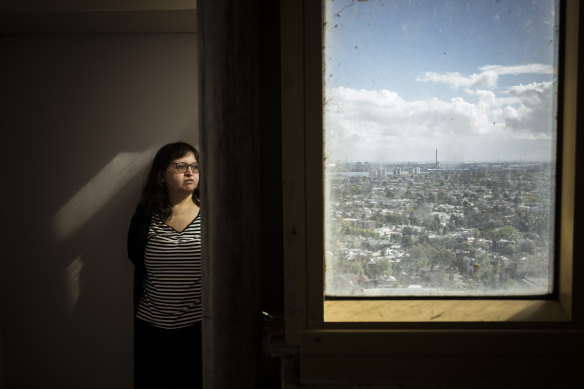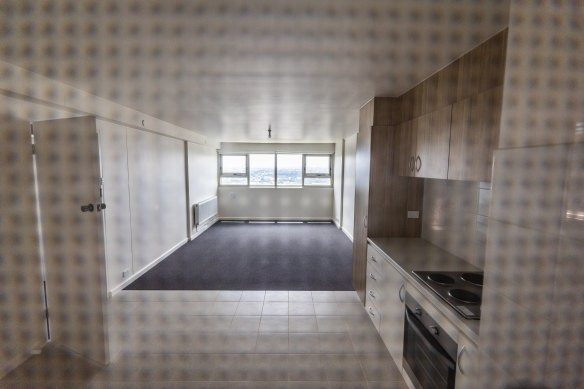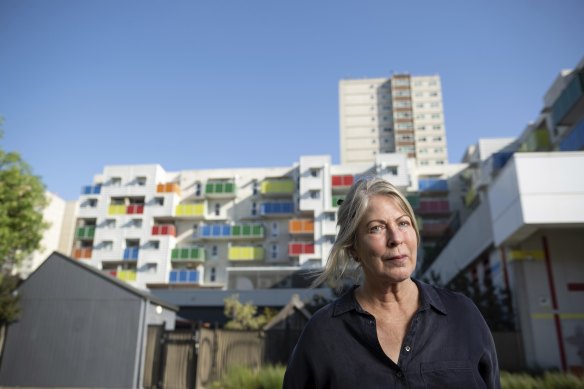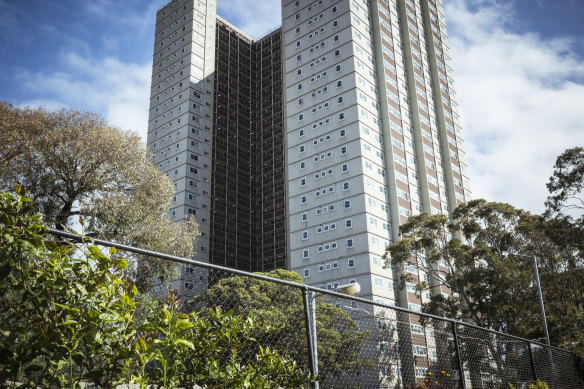
Save articles for later
Add articles to your saved list and come back to them any time.
In its much-hyped housing statement this week, the Andrews government announced a plan to demolish every remaining public high-rise tower in Melbourne and replace them with larger developments of a mix of social and market housing. But experts say refurbishing or infilling the existing towers could be cheaper and less disruptive than en masse relocations and razing the sites.
The dozens of distinctive towers – ranging between 50 and 70 years old – are dotted across the city in Williamstown, South Melbourne, St Kilda, Richmond, South Yarra, Prahran, Brunswick, North Melbourne, Flemington, Footscray, Collingwood and Carlton.
South Melbourne’s Park Towers public housing tenant Soyla Poernomo.Credit: Chris Hopkins
Premier Daniel Andrews said this week the 44 towers represented “some of the most expensive square metres anywhere in the state” due to running costs and would be demolished progressively between now and 2051 under public-private partnerships.
Such rebuild models have been in play for many years as part of the government’s Public Housing Renewal Program, which is currently redeveloping at least nine low-rise public estates in partnership with the private sector. None are yet completed.
Not-for-profit architecture and research firm OFFICE conducted such a study of its own last year for low-rise Barack Beacon public housing estate in Port Melbourne, which is being redeveloped and where the last public tenant was evicted amid protest earlier this year.
The study argued the government could save $88 million – and the incalculable distress of moving vulnerable residents – by refurbishing the estate and building “infill” units between existing buildings, rather than razing and rebuilding.
“We proposed to do the infill first and relocate the residents into the new building and then refurbish the old ones and do it sequentially like that,” said Simon Robinson, managing director at OFFICE.
“Obviously, it’s not ideal to live next to a construction site, but it’s about giving residents the option to stay there.”
Robinson said understanding the cost-benefit analyses for the demolition of each of the 44 different sites was “extremely important” because not all towers would necessarily be in the same condition. Some, including Atherton Gardens Estate in Fitzroy, have been renovated or refurbished recently.
“It’s the only way you could truly understand the appropriate way to renew these sites. Without that report you’re making a judgment across the whole city rather than individual buildings and communities,” he said.
According to the government’s plan, the 10,000 public housing tenants would progressively be moved elsewhere while their buildings are razed and rebuilt. The new buildings would hold three times as many people as the current towers – but only 10 per cent of that housing stock is set aside for “social” housing. It is unclear if that means 11,000 public housing tenants will return or whether they will be community housing tenants with non-government agencies.
Another 19,000 people in some kind of private housing will also move into the newly developed estates. The latest Homes Victoria data reveals 58,131 low-income households are waiting for long-term social housing.
A renovated apartment in Fitzroy’s Atherton Gardens photographed last December.Credit: Jason South
Soyla Poernomo, 36, has lived at Park Towers in South Melbourne for five years in a one-bedroom unit with her cat, Nutmeg.
She says the building has its problems: it can be hot in summer, there’s rubbish dumped in the stairwells, and she’s had rats chew through her wall. But she says she prefers it to her previous public rental a few streets away, which was much smaller.
“There’s more sense of a community here,” she says.
There’s a large contingent of residents from Russia, Ukraine and Belarus at Park Towers. The elderly eastern Europeans natter together each day on chairs outside the building, and there’s a community garden where the diversity of herbs – dill for Russian dishes and rue for Ethiopian cooking – speaks to the mingling of different cultures in the towers.
“I think [the redevelopment plan] will be good and bad,” says Poernomo, who was already planning to apply for a public rental in regional Victoria to leave the towers before the premier’s announcement.
“Private rental people are not used to having people with drug issues around them.”
Urban geographer at Melbourne University Dr Kate Shaw in front of a social housing block constructed on the Atherton Gardens public housing estate in Fitzroy. Credit: Penny Stephens
It’s unclear how the mix of housing will be designed under the tower redevelopment plan, which states five towers across Carlton, Flemington and North Melbourne will be completed by 2031.
But experiments of “salt and pepper” style mixing of social housing and private rentals was controversial during the pandemic lockdowns when the state government housed 2000 formerly homeless Melburnians in luxury apartments, which resulted in tensions and reports of violence, drug-dealing and theft.
Advocates say such models, when done well, can break down social barriers; the alternatives of discrete estates discriminate against low-income groups.
A 2017 study of a “mixed” redevelopment of public walk-up flats in Carlton criticised the final design as developers demanded separate blocks of private and public dwellings.
In the development, private residents of apartment buildings on Lygon and Rathdowne streets have exclusive access to a garden courtyard that residents in the neighbouring public building can only look at from their balconies. Public tenants were also separated from this garden by a 1.8-metre wall.
Park Towers at 332 Park Street in South Melbourne is one of 44 towers to be pulled down over the next 30 years.Credit: Chris Hopkins
University of Melbourne Urban Geographer Dr Kate Shaw, one of a group of six academics who contributed to a damning joint paper in response the state’s housing statement this week, said there was a working example of successful “infill” at a public housing estate at Atherton Gardens.
The modern building with 152 apartments was built on a corner car park at Atherton Estate entirely for social housing, completed in 2013.
“That was a clear substantial increase in social housing on a public housing estate,” she said.
“Nobody had to move out, and it hasn’t disrupted the lovely open feel of the estate because it was built in a well-serviced corner right on the tram line. Why we are not pursuing that model leaves me gobsmacked.”
A government spokesman said that each tower redevelopment project would be subject to a business case and tender process which will be commercial in confidence “as is standard practice”. But he said retrofitting was not an option because of the design and age of the towers.
“To address the housing crisis, Victoria needs more housing of all kinds in the places people want to live,” he said.
“Developing mixed housing sites helps us tackle the crisis and build stronger communities.”
Get the day’s breaking news, entertainment ideas and a long read to enjoy. Sign up to receive our Evening Edition newsletter here.
Most Viewed in National
From our partners
Source: Read Full Article



